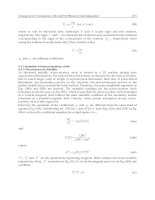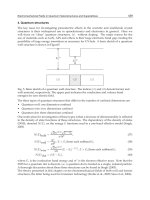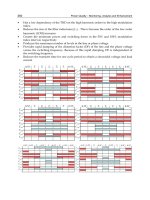LEGO MINDSTORMS - Robotics Invention System-2 Projects part 12 pot
Bạn đang xem bản rút gọn của tài liệu. Xem và tải ngay bản đầy đủ của tài liệu tại đây (1.7 MB, 25 trang )
Robot 9 • The SpinnerBot
261
The Right Gripper
The Right Gripper sub-assembly differs from the Left Gripper in that it contains a 12t bevel gear,
which provides power to the pair of grippers. The 16t gear will drive the Left Gripper so that they
move as a pair.
Right Gripper Step 0
Right Gripper Step 1
Leave a small gap
between the axle joiner
and the 16t gear to
allow them to
move smoothly
and freely.
Robot 9 • The SpinnerBot
262
Right Gripper Step 2
Set aside the Right Gripper sub-assembly.
You’ll need it in Spinner Arms Step 0.
The Gripper Drive Shaft
The Gripper Drive Shaft transfers power from the Arm Pivot (the next sub-assembly you’ll build) to
the Gripper Arms you have just built.
Slide the 8t gear
onto the axle until
there is a half-stud
width of axle showing
at the end. Achieve this
spacing by sliding a spare half-length bushing onto the
tip of the axle, snugging the gear up to it, and then
removing it.
You will use this sub-assembly in Spinner Arms Step 2.
Robot 9 • The SpinnerBot
263
Gripper Drive Shaft Step 0
The 12t
bevel gear
goes on the very end
of the axle. If you allow
the axle to protrude, it may jam
against the Right Gripper Arm.
Gripper Drive Shaft Step 1
Robot 9 • The SpinnerBot
264
The Arm Pivot
This sub-assembly serves two important functions: It provides power to the Gripper Arms, and once
those arms are closed around an object, it serves as the pivot for the entire lifting arm. This happens
because the 8t gear in the Gripper Drive Shaft can no longer turn once the grippers are closed. The
force from the 24t crown gear in the Arm Pivot lifts the entire arm instead, and the flag leaves the
ground.
Arm Pivot Step 0
Leave a one-and-a-
half stud space at the end
of the axle, and a one-stud
space between the two bushings.
Robot 9 • The SpinnerBot
265
Arm Pivot Step 1
Slide the gear up the
axle until it sits snugly
between the two half-
length bushings.
Arm Pivot Step 2
Leave a one-
stud gap between
the 24t crown gear
and the first six-stud
TECHNIC beam.
Arm Pivot Step 3
The three-
quarter-length pin
serves as a stop to
limit how far the
arm can lift. Later, you
will attach the vertical piece to
the main Drive Mechanism in order
to provide reinforcement.
Robot 9 • The SpinnerBot
266
Arm Pivot Step 4
Set the Arm Pivot aside for
now. You will need it in
Spinner Arms Step 3.
The Spinner Arms
The Spinner Arms are the business end of the SpinnerBot. The power from the Arm Pivot axle sub-
assembly will open and close the grippers, and will also raise and lower the Arm.
Robot 9 • The SpinnerBot
267
Spinner Arms Step 1
As you attach the two
grippers using the yellow
plate, try to match the
positions of the grippers while the
16t gears mesh. There will always be a
slight difference in orientation (the
width of half a tooth, or 15
degrees), but if they are
far off, the grippers will not
close properly. Once you
attach the plate, you can test rolling them
open and closed in unison.
Spinner Arms Step 2
Locate the Gripper Drive
Shaft sub-assembly built
previously and attach it
as shown.
Make sure that the two 1x2 TECHNIC beams on the
shaft are as far apart as possible before you snap
them onto the 2x8 plate.
Spinner Arms Step 0
Locate the Right and Left Gripper
sub-assemblies built previously
and place them beside each other,
as shown.
Robot 9 • The SpinnerBot
268
Spinner Arms Step 3
Locate the Arm Pivot sub-assembly
built previously, and attach it as shown.
The 24t crown gear and 8t gear
should mesh neatly.
Spinner Arms Step 4
Slide the 12t gear, teeth-down, onto the axle
of the Right Gripper sub-assembly, until it meshes
with the gear on the Drive Shaft sub-assembly. You will
want to support the end of the #4 axle with a fingertip as
you do so, to prevent it slipping down from the pressure.
Robot 9 • The SpinnerBot
269
Spinner Arms Step 5
The 2x8 plate should fit snugly
on top of the 12t bevel gear. The
thin ring on the back of the gear
will actually inset into the
underside of the 2x8 plate.
Spinner Arms Step 6
Robot 9 • The SpinnerBot
270
Spinner Arms Step 7
Each part
required for this step is a 2x2
TECHNIC plate with an unusual under-
side: Underneath each plate is a rounded
hole that allows an axle or TECHNIC pin to be
inserted crosswise through the plate.
Flip the sub-assembly over to attach these plates to the under-
side. The 16t gears from the grippers will overlap the plates
slightly. You may need to loosen the gears slightly on their axles to
allow the plates above them. Test the grippers to make sure that they
still open and close smoothly.
Spinner Arms Step 8
Turn the assembly
upright again to snap the
three-quarter length pins into each
of the two plates and two bricks you just
attached.
Robot 9 • The SpinnerBot
271
Spinner Arms Step 9
Snap the half-beams onto the three-quarter
length pins to hold the arm firmly together.
Set the Spinner Arms sub-assembly aside;
you will need it in Final Step 18.
The Touch Pads
The Touch Pads are the probes with which the SpinnerBot detects a flag. Each Touch Pad is built so
that its center of gravity is below the connector. As a consequence, the pads will hang level with the
ground regardless of how you orient the SpinnerBot. The Touch Pads are just wide enough to sense
the flag if it is in range of the grippers, and to miss it otherwise.
Right Touch Pad
Left Touch Pad
Robot 9 • The SpinnerBot
272
Touch Pads Step 0
We’ll start by building the Right
Touch Pad first. The angled piece in
this step is a gray angle connector
with the number 5 printed on it.
Touch Pads Step 1
The new
piece is a
blue connector
with the number 1
printed on it.
Touch Pads Step 2
This is the completed Right
Touch Pad. Set this off to the side.
You will use this sub-assembly in
Touch Mechanism Step 3.
Touch Pads Step 3
Now we’ll build the Left
Touch Pad. Again, in this
step, the angled piece is a
gray angle connector with
the number 5 printed on it.
Touch Pads Step 4
The new piece is a blue connector
with the number 1 printed on it.
Robot 9 • The SpinnerBot
273
Touch Pads 5
This is the completed Left Touch
Pad. Set this off to the side. You
will use this sub-assembly in Touch
Mechanism Step 3.
The Touch Mechanism
All of the sensors on the SpinnerBot are located on this sub-assembly. The touch sensors are
plunger-style, and are wired in parallel. This means that the SpinnerBot does not normally distin-
guish between one sensor or the other—rather, they are both attached to the same Input Port, so
touching either will trigger the flag-grabbing action.
However, if you wire each sensor to a separate port, you can enhance your program to give the
SpinnerBot a more sophisticated behavior.
The light sensor is also located here, and as with any line-sensing robot, it is pointed directly at
the ground.
The entire Touch Mechanism sub-assembly barely clears the ground. In fact, the Touch Pads
serve as forward skids for the robot when it lifts a flag, since the heavy flag moves the center of
gravity forward of the wheel axles.
Robot 9 • The SpinnerBot
274
Touch Mechanism Step 0
Touch Mechanism Step 1
Robot 9 • The SpinnerBot
275
Touch Mechanism Step 2
Locate and
attach the Right and
Left Touch Pads as shown.
The two wire ends depicted in
the parts list both belong to a
single five-inch (13 cm) wire.
Connect one touch sensor to the
other with the short wire.
Touch Mechanism Step 3
Robot 9 • The SpinnerBot
276
Touch Mechanism Step 4
Set the Touch Mechanism sub-
assembly aside. You will need it
in Final Step 20.
The wire end in this step belongs to a
48-inch (120 cm) wire. Connect one end
of this wire on top of the short wire on
the right touch sensor, as shown.
Putting It All Together
Now you will build the chassis of the SpinnerBot, and attach each of the sub-assemblies you’ve set
aside. Take care to position each one properly.
As you slide the
differential housing
onto the axle, slip the
12t gear onto the end
of the axle. This will
hold the loose 12t gear
from the previous step in place.
The new 12t gear should just
barely cover the end of the axle.
Robot 9 • The SpinnerBot
277
Final Step 0
Begin by assembling the transmission. Slide
the half-length bushing onto the axle, leaving
one-and-a-half studs of axle exposed on the
near side of the bushing.
Final Step 1
Place the 12t bevel gear on
the short stub inside the
barrel of the differential.
Final Step 2
Final Step 3
Add the second axle, sliding the 12t gear over
the end as it enters the differential. Continue
sliding the axle through the gear until a full
stud’s worth of the end of the axle is exposed
inside the differential. It should just brush the
axle tip on the opposite side of the differential.
Robot 9 • The SpinnerBot
278
Final Step 4
Final Step 5
Final Step 6
Complete the
transmission by adding
the last 24t crown gear.
Final Step 7
You will need the Inner RCX Bracket sub-
assembly that you set aside earlier. Make
certain that it has all three pins—it would
be very difficult to add them later on!
Robot 9 • The SpinnerBot
279
Final Step 8
Reinforce the chassis with a cap of plates.
Final Step 9
Now flip over the chassis and add plates
to the underside. This makes a rigid
frame for the rest of the SpinnerBot.
Final Step 10
Attach the Left and
Right Side Frame sub-
assemblies to the SpinnerBot, as
shown. Attach the Left Side Frame first
by sliding the exposed end of the Left Side
Frame axle into the hole on the end of the chassis.
Then repeat the process with the Right Side Frame.
Robot 9 • The SpinnerBot
280
Final Step 11
Final Step 12
Snap the Outer RCX Bracket sub-
assembly onto the end of the
chassis, securing the
RCX. The Outer
RCX Bracket and
RCX can be
readily removed.
Final Step 13
Flip the robot
over and add
the skid plate to
the underside of the
RCX. This plate provides a
reasonably low-friction
bearing for the SpinnerBot, since it is
almost perfectly balanced over the wheels.
The RCX snaps
onto the three-
quarter
length
pins on
the Inner
RCX Bracket
sub-assembly. The
position of the RCX is key
to a mobile robot, as it is
typically the most important factor
in the balance of the robot.
Robot 9 • The SpinnerBot
281
Final Step 14
Attach the Drive Mechanism sub-
assembly as shown. The dangling
1x4 TECHNIC beam from the Drive
Mechanism should slip between
the differential and the Inner RCX
Bracket, aligning with the half-
length pin there. Once you have
firmly attached the sub-
assembly, reach in with
your fingers or a narrow
plate and firmly snap the 1x4
TECHNIC beam onto the half-
length pin. This will prevent the
Drive Mechanism from
gradually working apart.
Final Step 15
Attach the Lower Arm Drive sub-
assembly as shown. As you
attach the drive, lift the dangling
axle connector you added in
Lower Arm Drive Step 5 and set
it on top of the 24t gear from
the Right Side Frame. This will
prevent the right wheel
from rotating backward. Test
this by rotating the protruding
right axle either way. It should
move freely in one direction and
lock in the other. If it does not,
try re-seating the sub-assembly.
Robot 9 • The SpinnerBot
282
Final Step 16
Attach the Arm Drive sub-assembly as
shown. The dangling black half-beam should
be aligned with the two protruding pins
further down on the body of the
SpinnerBot. Once the Arm Drive is seated,
this half-beam has to be snapped onto the
pins, securing the entire column in place.
Take the blue rubber band that is
loosely attached to the Lower Arm
Drive’s shaft, and slip it securely around the
groove of the small pulley on the shaft.
Once it is in place, stretch the band around
the larger pulley on the arm motor. The
band be lined up vertically, and it should
fit snugly without crossing over itself.
Final Step 17
Looking at the
left side of the Arm
Drive, connect the
two liftarms to the side of the
motor housing using the axle pins. This
will prevent the housing from coming
loose under strain.
Insert pins here
Robot 9 • The SpinnerBot
283
Final Step 18
Final Step 19
Attach the
wheels and tires. Take a
moment to rotate each
wheel. The left wheel should
freely spin backward while the right
wheel freely spins forward. If the wheels do
not move freely, take a moment to adjust any
parts that might be in contact with them.
Attach the Spinner Arms sub-assembly. Slide the loose end of the
Arm Pivot into the right side of the robot. The end should be
secured using the 5-length gray half-beam from the Lower Arm
Drive. Firmly press the beam at the other end of
the Arm Pivot onto the Drive Mechanism. The 5-
length gray half-beam at this
end of the
Arm Pivot
will align with and clip onto
a three-quarter length pin
attached to the side of the
Drive Mechanism.
Robot 9 • The SpinnerBot
284
Final Step 20
Secure the Touch Mechanism by pinning
each upright arm with a #6 length axle
inserted into the green 1x2 brick with axle
hole.
■
Connect the light sensor to Input
Port 1 (I ran the wire through the
body and secured it using the pin on
the corner of the Drive Mechanism).
■
Connect the touch sensors to Input
Port 2 (I ran a long wire down the
right side of the robot, securing the
excess with a black rubber band).
■
Connect the arm motor to Output
Port A.
■
Connect the main drive motor to
Output Port C.
Robot 9 • The SpinnerBot
285
The Spinner Flag
These are the flags that the SpinnerBot will pick up as it travels around its track. You can build two
of these with the extra parts in the RIS.
These flags are based on a design that rtlToronto (among others) used in a competition in which
the robot had to pick up the flag to win. The large top and the skinny body make the flag easy to
pick up.
Spinner Flag Step 0
The connector is a blue angle
connector with the number 2 printed
on it. The large pulley provides a stop
that is easy for the SpinnerBot to grab.









